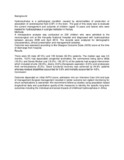| dc.contributor.author | Kyalo, MUSAU C | |
| dc.contributor.author | Nganga, NGANGA H | |
| dc.contributor.author | Kamau, MBUTHIA N | |
| dc.date.accessioned | 2015-09-28T09:11:55Z | |
| dc.date.available | 2015-09-28T09:11:55Z | |
| dc.date.issued | 2015 | |
| dc.identifier.citation | Kyalo, MUSAU Christopher, NGANGA Hudson Nganga, and MBUTHIA Nganga Kamau. "CLINICAL STUDIES/ETUDES CLINIQUES MANAGEMENT AND FUNCTIONAL OUTCOME OF CHILDHOOD HYDROCEPHALUS AT THE KENYATTA NATIONAL HOSPITAL, NAIROBI PRISE EN CHARGE ET EVOLUTION FONCTIONNELLE DE L’HYDROCEPHALIE DE L’ENFANT AU KENYATTA NATIONAL HOSPITAL, NAIROBI." Sommaire/Table of Contents 34.1 (2015): 26. | en_US |
| dc.identifier.uri | http://ajns.paans.org/dist/data/2015Vol34No1.pdf#page=26 | |
| dc.identifier.uri | http://hdl.handle.net/11295/91544 | |
| dc.description.abstract | Background
Hydrocephalus is a pathological condition caused by abnormalities of production or absorption of
cerebrospinal fluid (CSF) in the brain. The goal of this study was to evaluate the current management and
outcome of children (aged 13 years and below) who were treated for hydrocephalus in a single institution in
Kenya.
Methods
A retrospective analysis was conducted on 200 children who were admitted to the neurosurgical unit at the
Kenyatta National Hospital and diagnosed with hydrocephalus between January 2000 and April 2013. The
records were analyzed for demographic characteristics, clinical presentation and management variables.
Outcome was assessed according to the Glasgow Outcome Scale (GOS) score at the time of discharge
from hospital.
Results
There were 95 male (47.5%) and 105 female (52.5%) patients. The median age was 3.5 months. 16.5%
had associated congenital anomalies, the commonest being spina bifida (18.2%) and Dandy Walker cyst
(18.2%). 162 (81%) of the patients had surgical intervention which included shunts (92.6%), drains (0.6%),
therapeutic aspiration (0.6%) and endoscopic third ventriculostomy (6.2%). Good functional recovery was
achieved by 94.6% patients whereas residual disabilities accounted for 0.6% and mortality accounted for
4.8%.
Conclusion
Outcome depended on initial AVPU score, admission into our Intensive Care Unit and type of management.
Surgical management resulted in better outcome but vigilant monitoring for shunt complications is
warranted. We recommend follow-up studies using population-based longitudinal data and quantitative
quality-of-life measures to identify the specific long-term outcomes including the individual and social
impacts of childhood hydrocephalus in Africa | en_US |
| dc.language.iso | en | en_US |
| dc.publisher | University of Nairobi | en_US |
| dc.title | Management and functional outcome of childhood hydrocephalus at the Kenyatta national hospital, Nairobi | en_US |
| dc.type | Article | en_US |
| dc.type.material | en_US | en_US |

